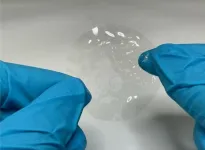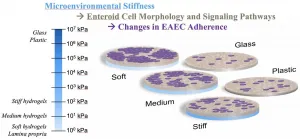Eco-friendly plastic from cellulose and water
Göttingen University researchers create new kind of environmentally friendly bioplastic with hydroplastic polymers
2021-07-22
(Press-News.org) Plastics offer many benefits to society and are widely used in our daily life: they are lightweight, cheap and adaptable. However, the production, processing and disposal of plastics are simply not sustainable, and pose a major global threat to the environment and human health. Eco-friendly processing of reusable and recyclable plastics derived from plant-based raw materials would be an ideal solution. So far, the technological challenges have proved too great. However, researchers at the University of Göttingen have now found a sustainable method - "hydrosetting", which uses water at normal conditions - to process and reshape a new type of hydroplastic polymer called cellulose cinnamate (CCi). The research was published in Nature Sustainability.
Plastics are polymers, meaning that their molecular structure is built up from a large number of similar units bonded together. Currently, most plastics are manufactured using petrochemicals as raw materials, which is damaging to our environment to both extract and dispose of. In contrast, cellulose, which is the main constituent of plant cell walls, is the most abundant natural polymer on earth, constituting an almost inexhaustible source of raw material. By slightly modifying a very small portion of the chemistry of cellulose by introducing a "cinnamoyl" group, the researchers succeeded in making a specific CCi that is suitable for the formation of a new type of bioplastic with hydroplastic (ie soft and mouldable on contact with water) polymers.
This means that it can be moulded using little more than water at everyday temperature and pressure. This unique method - known as hydrosetting - enabled the researchers to produce a variety of shapes simply by immersing the bioplastic in water and leaving it to dry in the air. The moulded shapes kept their stability in the long-term and could be reshaped over and over again into a variety of 2D and 3D shapes. Although the plastic should not be used for direct contact with water - because it will lose its shape - it can hold water and be used in humid conditions. The CCi bioplastics showed high quality mechanical properties when compared with plastics that are currently widely used.
"Our research provides a feasible method to design other eco-friendly hydroplastics from renewable resources," explains Professor Kai Zhang from the University of Göttingen. "This should open up new avenues of research, stimulating further exploration of other sustainable bioplastics with superior mechanical properties and new features."
The hydrosetting process avoids expensive and complex machinery and harsh processing conditions. This eco-friendly method highly simplifies plastics manufacture, making their processing and recycling more economical and sustainable. "This research offers tremendous potential for bioplastics like this to be applied in many different situations, such as biology, electronics and medicine," says Zhang before adding: "In particular, the detrimental effects of plastics on the environment, which is damaging to all forms of life on earth, would be minimized by reusing hydroplastics with their unique features."
INFORMATION:
Original publication: Jiaxiu Wang, Lukas Emmerich, Jianfeng Wu, Philipp Vana and Kai Zhang, "Hydroplastic polymers as eco-friendly hydrosetting plastics" 2021, Nature Sustainability, DOI: 10.1038/s41893-021-00743-1. Or see the website: https://www.nature.com/articles/s41893-021-00743-1
Contact:
Professor Kai Zhang
University of Göttingen
Department of Wood Technology and Wood-based Composites
Faculty of Forest Sciences and Forest Ecology
Büsgenweg 4, 37077 Göttingen, Germany
Tel: +49 551 39 24505
Email: kai.zhang@uni-goettingen.de
https://www.uni-goettingen.de/de/research/618364.html
[Attachments] See images for this press release:

ELSE PRESS RELEASES FROM THIS DATE:
2021-07-22
HOUSTON -- (July 22, 2021) -- Researchers who want bacteria to feel right at home in the laboratory have put out a new welcome mat.
Rice University bioengineers and Baylor College of Medicine scientists looking for a better way to mimic intestinal infections that cause diarrhea and other diseases have built and tested a set of hydrogel-based platforms to see if they could make both transplanted cells and bacteria comfy.
As a mechanical model of intestinal environments, the lab's soft, medium and hard polyethylene glycol (PEG) hydrogels were far more welcoming to the cells that normally line the gut than the glass and plastic usually used by laboratories. These cells can then host bacteria like Escherichia coli that are sometimes pathogenic. The ability to study their ...
2021-07-22
Many people find it morally impermissible to put kidneys, children, or doctorates on the free market. But what makes a market transaction morally repugnant in the eyes of the public? And which transactions trigger the strongest collective disapproval? Researchers from the Max Planck Institute for Human Development and the Robert Koch Institute have addressed these questions. Their findings, published in Cognition, offer new entry points for policy interventions.
Would you be willing to sell a kidney or be paid to spend time on a date? If not, then ...
2021-07-22
Nuclear fusion offers the potential for a safe, clean and abundant energy source.
This process, which also occurs in the sun, involves plasmas, fluids composed of charged particles, being heated to extremely high temperatures so that the atoms fuse together, releasing abundant energy.
One challenge to performing this reaction on Earth is the dynamic nature of plasmas, which must be controlled to reach the required temperatures that allow fusion to happen. Now researchers at the University of Washington have developed a method that harnesses advances in the computer gaming industry: It uses a gaming graphics card, or GPU, to run the control system for their prototype fusion reactor.
The team published ...
2021-07-22
As any juror will tell you, piecing together a crime from a series of documents tendered in a courtroom is no easy feat, especially when a person's future hangs in the balance.
Delivering the correct verdict on car accident and murder cases is contingent on good spatial awareness, but short of being at the scene of the crime, the room for error is large.
However, thanks to the advent of virtual reality (VR), jurors now have a better chance of making the right decision.
A new study published by the University of South Australia provides overwhelming evidence ...
2021-07-22
The discovery of a Roman road submerged in the Venice Lagoon is reported in Scientific Reports this week. The findings suggest that extensive settlements may have been present in the Venice Lagoon centuries before the founding of Venice began in the fifth century.
During the Roman era, large areas of the Venice Lagoon which are now submerged were accessible by land. Roman artefacts have been found in lagoon islands and waterways, but the extent of human occupation of the lagoon during Roman times has been unclear.
Mapping the lagoon floor using sonar, Fantina Madricardo and colleagues discovered 12 archaeological structures aligned in a northeasterly direction for 1,140 metres, in an area of the lagoon ...
2021-07-22
Newly-hatched pterosaurs may have been able to fly but their flying abilities may have been different from adult pterosaurs, according to a study published in Scientific Reports.
Pterosaurs were a group of flying reptiles that lived during the Triassic, Jurassic and Cretaceous Periods (228 to 66 million years ago). Due to the rarity of fossilised pterosaur eggs and embryos, and difficulties distinguishing between hatchlings and small adults, it has been unclear whether newly-hatched pterosaurs were able to fly.
Darren Naish and colleagues modelled hatchling flying abilities using previously obtained wing measurements from four established hatchling and embryo fossils from two pterosaur species, ...
2021-07-22
Gene therapy in mouse models showed promise in preventing vision loss or blindness from serious retinal injury including optic nerve damage, and from retinal disease including diabetic retinopathy and glaucoma, Mount Sinai researchers report. Their study, published in the July 22 online publication of Cell, could transform treatment for those at risk of major vision loss from retinal degenerative diseases, which currently have no cure.
The researchers focused on retinal ganglion cells, which process visual information by sending images to the brain. These cells can degenerate as a result of retinal injury and retinal disease. ...
2021-07-22
Geneticists from Trinity College Dublin have discovered how a specific genetic mutation called H3K27M causes a devastating, incurable childhood cancer, known as diffuse midline glioma (DMG), and - in lab studies working with model cell types - successfully reverse its effects to slow cancer cell growth with a targeted drug.
Their landmark work - just published in leading international journal, Nature Genetics and supported by Worldwide Cancer Research and The Brain Tumour Charity - translates crucial new understanding of the genetics of DMG progression into ...
2021-07-22
A form of gene therapy protects optic nerve cells and preserves vision in mouse models of glaucoma, according to research supported by NIH's National Eye Institute. The findings suggest a way forward for developing neuroprotective therapies for glaucoma, a leading cause of visual impairment and blindness. The report was published in Cell.
Glaucoma results from irreversible neurodegeneration of the optic nerve, the bundle of axons from retinal ganglion cells that transmits signals from the eye to the brain to produce vision. Available therapies slow vision loss by lowering elevated eye pressure, however some glaucoma progresses to blindness despite normal eye pressure. Neuroprotective therapies would be a leap forward, meeting ...
2021-07-22
Advances in microscopy have enabled researchers to picture loops of DNA strands for the first time. The images reveal how the human genome organises itself in three-dimensional space at much higher resolution than previously possible.
The findings, published in a new study in the journal Molecular Cell, also reveal that the process of DNA being copied into RNA - transcription - indirectly shapes the architecture of the genome. An international team led by Pia Cosma at the Centre for Genomic Regulation (CRG) in Barcelona and Melike Lakadamyali at the Perelman ...
LAST 30 PRESS RELEASES:
[Press-News.org] Eco-friendly plastic from cellulose and water
Göttingen University researchers create new kind of environmentally friendly bioplastic with hydroplastic polymers



